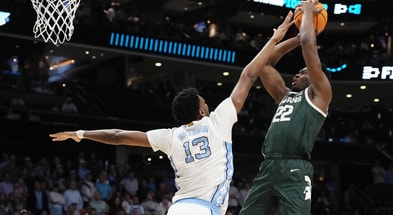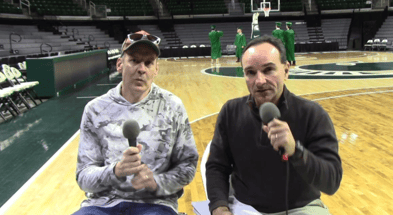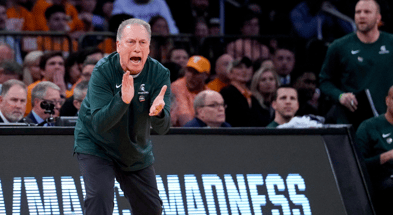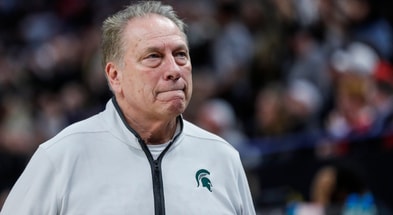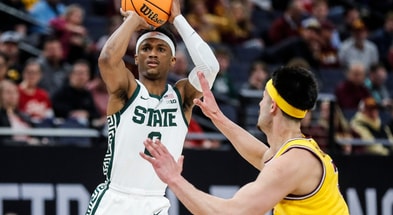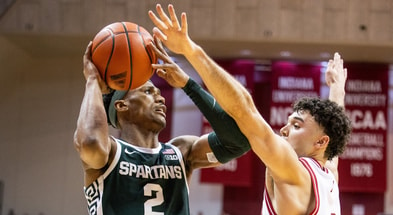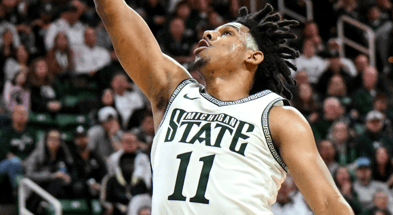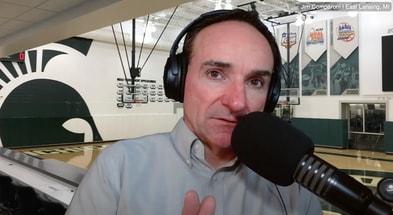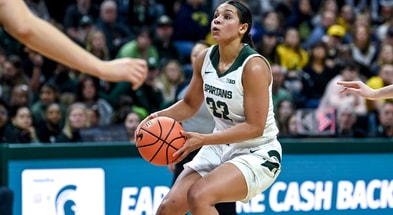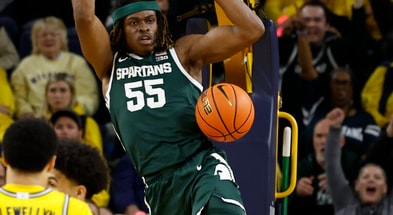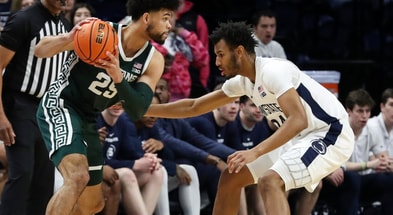3&Out: Michigan State outplayed at the four and five in loss to Illinois
Michigan State led by as many as seven points in the second half, but couldn’t make enough plays on either end to prevail in a 75-66 loss at Illinois. With the defeat, the Spartans saw their seven-game win streak come to an end. Now Michigan State must regroup to prepare for a Monday afternoon game against Purdue, with lingering questions about the health of senior forward Malik Hall, who re-injured an ankle hurt in a win last weekend.
Continue below for a basketball 3&OUT:
1. Michigan State needed Malik Hall down the stretch.
Michigan State tied this game, 60-60, on a Tyson Walker jumper with 5:47 to play. And a break here or there, or better decision-making, may have turned this game in Michigan State’s favor down the stretch.
What the Spartans really needed late in the second half was the presence of Malik Hall. Losing Hall to an ankle injury was one of the worst things that could have happened with this game hanging in the balance. Without Hall available, Michigan State was forced to defend 6-foot-9 forward Matthew Mayer guard Jaden Akins, who is a good defensive player, but not an ideal defender for that situation.
With Hall out of the game, we also saw Joey Hauser truly wear down for the first time this season. Hauser played a strong game for the Spartans most of the night. Down the stretch, however, veteran Illinois forward Coleman Hawkins had more juice that Hauser. If Hall hadn’t been on the bench with an ankle injury, things might have been different.
Going into this game, I felt that Hall was the potential X-Factor for Michigan State. He is the guy that needed to have a big game to offset the Illinois duo of Hawkins and Mayer as well as lend a hand against 6-foot-6, 225-pound guard Terrence Shannon Jr.
When Hall left the game with an ankle injury, the momentum pendulum that was already beginning to favor Illinois, swung hard in favor of the home team. Without Hall on the floor, Michigan State no was no longer able to dominate the glass as they had up until his departure.
Michigan State ended up outrebounding Illinois by 12 in this game. At one point, the Spartans had a 32-18 rebounding advantage on Illinois in the second half. From the midway point of the second half forward, Illinois outrebounded Michigan State 12-10.
2. Illinois won this game at the four and five
Michigan State coach Tom Izzo was concerned about Texas Tech transfer Terrence Shannon Jr. going into this game. And it didn’t take long the Fighting Illini’s leading scorer impact this game.
Shannon scored 15 of the first 19 points for Illinois and some of those buckets were far too easy. Live-ball turnovers by Michigan State enabled some of Shannon Jr.’s first-half success. Shannon also made a tough 3-pointer with Hall contesting, but too many of his early looks were the result of unforced errors.
The Spartans’ defense of Shannon improved as the first half progressed. Michigan State forced Shannon to take some awkward perimeter jumpers in the final 10 minutes of the opening half. As Michigan State’s defense improved, Shannon stopped taking as many shots, and the Spartans built a lead.
While Shannon shouldered the scoring burden early, The Fighting Illini won this game on the play of their forwards and center in the second half. Baylor transfer Matthew Mayer was the player of the game for Illinois. He scored 15 points in the second half and his impact on defense was undeniable, blocking four shots for the Fighting Illini.
Mayer wasn’t the only Illinois four-man who hurt Michigan State. Illinois got several big plays from Coleman Hawkins in the second half. Hawkins hit a big three late in the second half, and he also had a couple of critical offensive rebounds which give Illinois second-chance scoring opportunities.
Beyond the collective impact of Mayer and Hawkins, Illinois also got a huge lift inside from center Dain Dainja, a Baylor transfer, who scored 20 points on 8-of-12 shooting for the Illinois.
“Dainja killed us,” Izzo said. “He hasn’t been doing that.”
While Michigan State did a nice job of containing the Fighting Illini’s collection of athletic guards and wings including Shannon, the Spartans fell short in containing Fighting Illini forwards and centers.
3. Michigan State didn’t need threes to win this game
Michigan State didn’t make a 3-pointer against the Illinois, but the Spartans didn’t need to make a three to win this game. Michigan State needed to play better defense and make more of the open mid-range jumpers and lay-ups that were missed.
The mid-range jumper was Michigan State’s best friend in the first half. Before the Spartans were able to convert several scoring chances at the rim off-the-dribble, Michigan State had success knocking down the mid-range jumper. The Spartans have had a lot of success with the mid-range jumper against teams that aggressively close out on the perimeter to take away the 3-point line. The Spartans feasted on the mid-range jumper earlier this month when they played Nebraska at the Breslin Center.
The mid-range jumper was pivotal for the Michigan State offense in this game. Illinois leads the Big Ten in blocked shots, and some of the shots that Michigan State has been able to get with regularity against other teams weren’t going to be there against Illinois. The Fighting Illini blocked seven shots in the first half. Several of those blocks were the result of contesting shots at the rim. The Fighting Illini block party slowed down as Michigan State knocked down mid-range jumpers. And as those mid-range jumpers started to fall for the Spartans, point-blank looks at the rim on drives to the basket began to materialize.
Michigan State continued to have mid-range opportunities in the second half. The Spartans missed several open shots that might have prevented Illinois from regaining momentum had they gone down. There were also times in which Michigan State guards turned down mid-range shots that they probably should have taken. Tyson Walker was the guilty part on two of those missed scoring opportunities. Instead of taking good mid-range jumpers, Walker opted to pass the ball. Both times, those passes resulted in turnovers.
One of the pivotal stretches of this game came just inside of five minutes remaining in the second half. Hawkins had just hit a 3-pointer to put Illinois up by 63-60. Hoggard tried to answer by chucking a 3-pointer, which missed. The Fighting Illini turned a three-point lead into five on the next possession, when Dainja scored over Sissoko.
“Dainja, give him credit,” Izzo said. “He kicked our butt single-handedly. I thought they went into him and we quit checking.”
Hoggard played a gutsy game for Michigan State. He led the Spartans in scoring with 20 points on 8 of 16 shooting. That missed three, however, was a critical error for the junior point guard and there were others.
“A.J. just had a little tough stretch and I don’t think we coached as good, I don’t think we played as good,” Izzo said. “Give them credit, they made some hellacious shots. And 48-percent free throw shooter (Dainja) maker four in a row.”
This game should be a learning experience for Michigan State’s veteran guards. Both Hoggard and Walker had some terrific moments for the Spartans. Each needed to be better than were, however, and the duo also combined for six of Michigan State’s nine turnovers in this game.
Nine turnovers isn’t terrible. Six turnovers by starting guards is manageable if those turnovers are accompanied by a high number of assists. Walker and Hoggard combined for just one assist. As a team, Michigan State managed just four assists on 28 field goals.
Zero 3-pointers and only four assists. That sounds like a recipe for failure, but defensive slippage is what bothered Izzo the most after this game.
“(Our) ball screen coverage sucked,” Izzo said.
That included Jayden Epps’ driving lay-up around Sissoko to give Illinois an insurmountable 73-66 lead with :45 seconds left.


